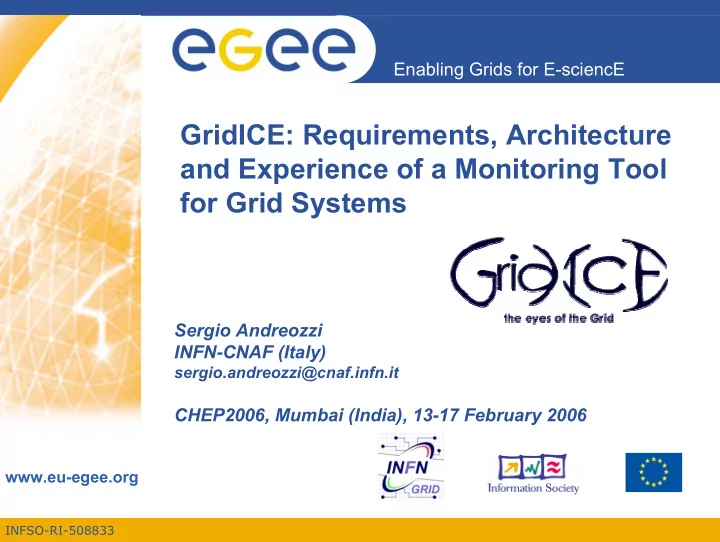

Enabling Grids for E-sciencE GridICE: Requirements, Architecture and Experience of a Monitoring Tool for Grid Systems Sergio Andreozzi INFN-CNAF (Italy) sergio.andreozzi@cnaf.infn.it CHEP2006, Mumbai (India), 13-17 February 2006 www.eu-egee.org INFSO-RI-508833
Outline Enabling Grids for E-sciencE • Monitoring a Grid – general introduction – users’ viewpoints • GridICE – architecture – implementation – experience INFSO-RI-508833 CHEP2006, Mumbai (India), 13-17 February 2005 2
What is Monitoring Enabling Grids for E-sciencE • We need monitoring functionalities : – to observe the composition, state and features of available resources – to analyze their behavior and performance – to detect and prevent fault situations • In the context of Grid computing, two important categories of monitoring systems are: – Application monitoring – Infrastructure monitoring We focus on INFSO-RI-508833 CHEP2006, Mumbai (India), 13-17 February 2005 3
Main Phases of the Monitoring Process Enabling Grids for E-sciencE abstract the huge number of received events in order to enable the consumer to Presenting draw conclusions about the operation of the monitored system Processing transmission of the events from the Distributing source to any interested parties sensors enquiring entities and encoding Generation the measurements according to a schema e.g., filtering according to some predefined criteria, or summarising a group of events INFSO-RI-508833 CHEP2006, Mumbai (India), 13-17 February 2005 4
Different Viewpoints /1 Enabling Grids for E-sciencE We focus on the following categories of users: – VO manager � actual set of resources accessible to VO members – Grid operator � all resources under responsibility of a Grid Operator Center – Site administrator � site resources offered to a Grid INFSO-RI-508833 CHEP2006, Mumbai (India), 13-17 February 2005 5
Enabling Grids for E-sciencE The GridICE Monitoring Tool INFSO-RI-508833 CHEP2006, Mumbai (India), 13-17 February 2005 6
Overview Enabling Grids for E-sciencE • GridICE: – a distributed monitoring tool for Grid systems � started in late 2002 (EU-DataTAG project) � is evolving in the context of EU-EGEE – fully integrated with the LCG-2.x Middleware � Metering and publishing of data can be configured via LCG standard installation mechanisms � Self-configurable collection and presentation • just give the URL of the root Grid Information Service (GIS) – using W3C standards to offer easy access to monitoring data INFSO-RI-508833 CHEP2006, Mumbai (India), 13-17 February 2005 7
Taxonomy Enabling Grids for E-sciencE • Taxonomy of monitoring systems [2] – S = sensor C = consumer P = publisher – R = republisher H = hierarchy of republishers •GridICE is a 2nd level of monitoring systems with a centralized republisher INFSO-RI-508833 CHEP2006, Mumbai (India), 13-17 February 2005 8
Sensor (S) and Publisher (P) Enabling Grids for E-sciencE • Sensor and publisher are in the scope of each administrative domain: – Sensor � Extension of the GLUE Schema-based information already available in the GIS adopted by LCG (i.e., Globus MDS 2.x): • fabric-level information • job monitoring • summary info for computing resources • network connectivity from a Grid viewpoint [4] – Publisher � Adopt the available Grid Information Service in LCG INFSO-RI-508833 CHEP2006, Mumbai (India), 13-17 February 2005 9
Metering and Site Level Distribution of extended information Enabling Grids for E-sciencE default choice – CERN Lemon Site – administrative domain Monitored Entity Site Collector Local Publisher Site Consumer Site Publisher Sensor Site Persistent Storage INFSO-RI-508833 CHEP2006, Mumbai (India), 13-17 February 2005 10
Central Republisher (R) Enabling Grids for E-sciencE Charts XML Notification HTML Data aggregation and abstraction Persistent storage Consumers Scheduler Discovery INFSO-RI-508833 CHEP2006, Mumbai (India), 13-17 February 2005 11
Screenshots Enabling Grids for E-sciencE INFSO-RI-508833 CHEP2006, Mumbai (India), 13-17 February 2005 12
Current Project Status Enabling Grids for E-sciencE – Integrated and deployed with LCG 2.x – Installed servers are monitoring Grid resources in the scope of: EGEE EGEE-SWE RDIG EGEE-SEE Grid.it GILDA CMS ATLAS EUMedGrid EUChinaGRID BalticGrid EELA BeGrid • Next steps: • Security and Privacy concerns • Dealing with heterogeneous publisher interfaces • Adopt new data-warehousing features available in the open source software • New service-specific sensors INFSO-RI-508833 CHEP2006, Mumbai (India), 13-17 February 2005 13
Conclusion Enabling Grids for E-sciencE • Monitoring of Grid systems is a complex activity in metering, distributing, processing and presenting • GridICE has been designed as an infrastructure monitoring tool for Grid systems • Requirements have been considered from three main different categories of users • The experience in production environments is positive – a stable service working in 24*7 • Future work targeted at dealing with multiple producer interfaces, improving security aspects and extending the set of measurements INFSO-RI-508833 CHEP2006, Mumbai (India), 13-17 February 2005 14
References Enabling Grids for E-sciencE Dissemination: http://grid.infn.it/gridice [1] S. Andreozzi , N. De Bortoli, S. Fantinel, A. Ghiselli, G. L. Rubini, G. Tortone, M. C. Vistoli GridICE: a monitoring service for Grid systems , Future Generation Computer System 21 (2005) 559–571 [2] S. Zanikolas, R. Sakellariou, A taxonomy of grid monitoring systems , Future Generation Computer Systems 21 (2005) 163–188 [3] S. Andreozzi, N. De Bortoli, S. Fantinel, G.L. Rubini, G. Tortone. Design and Implementation of a Notification Model for Grid Monitoring Events. CHEP04, Interlaken (CH), Sep 2004 [4] S. Andreozzi, A. Ciuffoletti, A. Ghiselli, C. Vistoli. Monitoring the Connectivity of a Grid . In Proceedings of the 2nd International Workshop on Middleware for Grid Computing (MGC 2004) in conjunction with the 5th ACM/IFIP/USENIX International Middleware Conference, Toronto, Canada, October 2004. INFSO-RI-508833 CHEP2006, Mumbai (India), 13-17 February 2005 15
Recommend
More recommend